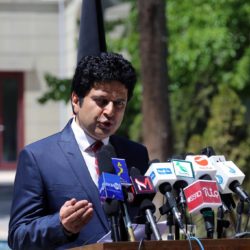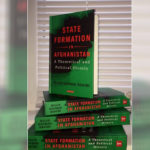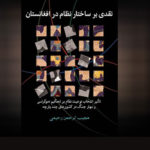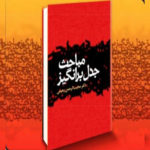By: Yaqub Ibrahimi
State formation in Afghanistan: a theoretical and political history, by Mujib Rahman Rahimi, London & New York, I.B. Tauris, 2017, xix + 335 pp., $99.00 (hardback), ISBN 978-1-78453-949-8
Rahimi provides a post-structural/postcolonial critique of the ‘official discourse of state formation in Afghanistan’. He draws on a set of theories, particularly post-structuralism, ‘discourse theory’, and postcolonial theory, in order to ‘study, explain, interpret, reconstruct, deconstruct, and problematize the official discourse’ (18–57). The discourse, according to the book, was built on four pillars: (1) the master signifier of Afghans and Afghanistan; (2) the myth of the formation of Afghanistan; (3) the tradition of Loya Jirga; and (4) the notion of invasion and resistance (58, 90). This discourse was Pashtun-centric and reinforced by colonial, or what the author calls the ‘post-Elphinstonian’, literature on state formation in Afghanistan (90–120). The book’s hypothesis and scope of argument are framed as follows.
My hypothesis is that Afghanistan and its nation-state is not as ancient and historical as it is argued in the official discourse. I further assume that the nation-state in Afghanistan is not the product of its own socio-economic, cultural and intellectual tradition. I argue that Afghanistan and its state is a colonial construction of the British and Russian Empires [sic] strategic rivalry of the nineteenth century in the region. I also argue that Afghans (Pashtuns), after their domination constructed an exclusionary narrative of their own relying on colonial knowledge and actively suppressing and marginalizing the identity of the non-Afghan habitants [sic] of the country. (3)
While the book’s application of a post-structural approach in challenging a well-established discourse of state formation in Afghanistan is quite novel, its alternative argument, which considers Afghanistan as a product of the imperial rivalries of the 1800s, is broadly discussed in previous accounts (e.g. Hopkins 2008; Rubin 1995, 3; Schetter 2005). Moreover, the book’s critique of the Pashtun-centric discourse, in itself, is not new. The discourse is challenged in a number of previous historical accounts which develop an alternative, mainly ethnocentric, narrative to this discourse (Mousavi 1998; Shahrani 1986). Therefore, Rahimi’s main contribution is the application of a different epistemological approach in criticizing the official discourse.
Drawing on two sets of primary and secondary data, the author ‘deconstructs’ the official discourse of state formation in Afghanistan and its convergent ‘colonial literature’. The first set of data the author draws on includes three subsets: primary historical texts written between 1300 and 1880 AD in Persian and Arabic (137–148); the British Indian Company and the British Empire’s treaties and official accounts (148–151); and a number of maps and atlases, and the historical geography of the region (151–153). The second set of data, which is categorized in the book as the ‘post-dislocation’ literature, includes secondary sources written by indigenous and foreign historians after the People’s Democratic Party of Afghanistan’s coup d’état of April 1978 (165–210). Using the two sets of data, the author challenges the official discourse according to which the Afghan state is the outcome of a three-thousand-year political development. Rahimi believes that the traditional narrative of state formation in Afghanistan, which naturalizes and historicizes the formation of Afghanistan, is constructed by the official discourse.
The author claims that the discourse and the image of state formation it produces are problematized by the historical data used in the book.
Contemporary Afghanistan, according to the author, was formed as a ‘modern state’ during the reign of Amir Abdurrahman in the 1880s, as a result of rivalries between the British and Russian Empires, and particularly with the support Abdurrahman received from the British Empire. The argument proceeds: the British Empire empowered Pashtuns to create the Afghan state; the Afghan state subordinated other ethnic groups of the country and constructed an official discourse; and the discourse, converging with the colonial knowledge, attempted to naturalize and historicize the formation of the Pashtun-dominated state (234–255).
While the book’s application of a post-structural approach in challenging a well-established discourse of state formation in Afghanistan is quite novel, its alternative argument, which considers Afghanistan as a product of the imperial rivalries of the 1800s, is broadly discussed in previous accounts (e.g. Hopkins 2008; Rubin 1995, 3; Schetter 2005). Moreover, the book’s critique of the Pashtun-centric discourse, in itself, is not new. The discourse is challenged in a number of previous historical accounts which develop an alternative, mainly ethnocentric, narrative to this discourse (Mousavi 1998; Shahrani 1986). Therefore, Rahimi’s main contribution is the application of a different epistemological approach in criticizing the official discourse.
The book, in my view, makes two major contributions to the knowledge of state formation in Afghanistan and suffers from a number of conceptual and methodological ambiguities. The first contribution is Rahimi’s ambitious approach to challenge a well-established discourse from an epistemological perspective which is rarely used in investigating the political development of Afghanistan. This could motivate future research to investigate some undiscovered
black holes in Afghan history and the process of development of the Afghan state. The book’s second contribution is the wide range of references documented and categorized in the book. Rahmani surprisingly collects both domestic and international sources on state formation in Afghanistan, organizing them in a single account. This alone makes the book a rich source of references for researchers interested in the political development of Afghanistan.
Thus, the book does a good job in bringing into focus the official discourse of state formation in Afghanistan and documentation of the relevant data. However, drawing on the ‘buffer state’ analogy of state formation, Rahimi’s consideration of Afghanistan as solely the outcome of rivalries between the British and Russian Empires in the region is problematic. He excludes domestic variables, such the post-1700 AD political development in the region under which Pashtuns emerged gradually as a dominant power, from the model of state formation in Afghanistan. But this ‘pre-colonial’ variable had an enormous impact, both on the British alignment with Pashtun emirs and on the ultimate formation of the ‘post-colonial’ Afghan state (Barfield 2010, 66–163). Exclusion of those variables from the model of state formation in Afghanistan affects the book’s explanatory power, making it difficult to understand why the British chose to align with Pashtun rulers but not with other dynasties, such as the Turko-Mongolians, which ruled the region for centuries (Barfield 2010, 66–67).
Moreover, it would be helpful if the author had reviewed the literature on ‘the state’ in detail. Relying on ‘Weberian conceptualization’ of the state, the author divides ‘the state’ straightforwardly into modern and pre-modern and emphasizes that the Afghan state emerged as a ‘modern state’ in the 1880s (42–43). This is inaccurate, because Afghanistan in the 1880s was only territorialized and emerged as a semi-sovereign state led by a king largely dependent on traditional sources of legitimacy (Hinsley 1967; Weber 1919). It entailed some aspects of the modern state, such as monopolization of power under a central government, but was not a modern entity in broader terms of political, socio-economic and cultural relations. A detailed review of the literature on ‘the state’, in this sense, could help reduce the conceptual ambiguity and generalization (Hinsley 1967; Jackson 2007).
Nonetheless, the book’s application of a new epistemology in studying the official discourse of state formation in Afghanistan and its documentation of a broad range of data contributes to the knowledge of the political development of Afghanistan. This contribution might motivate further scholarly debate on the official discourse of state formation in this country.
References
Barfield, T. 2010. Afghanistan: A Cultural and Political History. Princeton, NJ: Princeton University Press.
Hinsley, F. H. 1967. “The Concept of Sovereignty and the Relations between States.” Journal of International Affairs 21 (2): 242–252.
Hopkins, B. D. 2008. The Making of Modern Afghanistan. New York: Palgrave.
Jackson, R. 2007. Sovereignty: Evolution of an Idea. Cambridge: Polity Press.
Mousavi, S. A. 1998. The Hazaras of Afghanistan: An Historical, Cultural, Economic and Political Study. London: Curzon.
Rubin, B. 1995. The Search for Peace in Afghanistan: From Buffer State to Failed State. New Haven, CT: Yale University/Press.
Schetter, C. 2005. “Ethnoscapes, National Territorialisation, and the Afghan War.” Geopolitics 10 (1): 50–75.
Shahrani, M. N. 1986. “State Formation and Social Fragmentation in Afghanistan.” In The State, Religion, and Ethnic
Politics in Afghanistan, Iran, and Pakistan, edited by A. Banuazizi and M. Wiener, 23–74. New York: Syracuse University Press.
Weber, M. 1919/2004. The Vocation Lectures. Translated by Rodney Livingstone and edited by David Owen and
Tracy Strong. Indianapolis, Indiana: Hackett Publishing Company.
Yaqub Ibrahimi
Department of Political Science, Carleton University, Ottawa, Canada
yaqub.ibrahimi@gmail.com
© 2017 Yaqub Ibrahimi
https://doi.org/10.1080/02634937.2017.1399653
CENTRAL ASIAN SURVEY, 2017
https://www.tandfonline.com/doi/abs/10.1080/02634937.2017.1399653?journalCode=ccas20&fbclid=IwAR3qgBAIYLYXEME-ADVfAA1IdsGjP5zOXA-LT-PdvxtJ6mgcL-kJ2qG1JsE
State formation in Afghanistan a theoretical and political history









Feedback and Comment